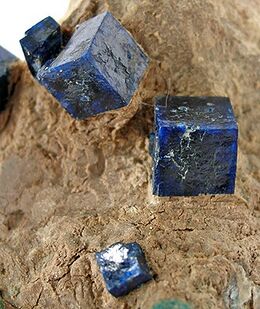Chemistry:Boleite
| Boleite | |
|---|---|
 | |
| General | |
| Category | Halide mineral |
| Formula (repeating unit) | KPb26Ag9Cu24(OH)48Cl62 |
| Strunz classification | 3.DB.15 |
| Crystal system | Isometric |
| Crystal class | Hexoctahedral (m3m) H-M symbol: (4/m 3 2/m) |
| Space group | Pm3m |
| Unit cell | a = 15.29 Å; Z = 1 |
| Identification | |
| Color | Deep Prussian blue to indigo |
| Crystal habit | Cubic crystals |
| Cleavage | [001] perfect |
| Fracture | Uneven |
| Mohs scale hardness | 3.0 – 3.5 |
| |re|er}} | Vitreous to pearly |
| Streak | Greenish blue |
| Diaphaneity | Translucent |
| Specific gravity | 5.054 |
| Optical properties | Isotropic |
| Refractive index | n = 2.05 |
| Other characteristics | |
| References | [1][2][3] |
Boleite is a complex halide mineral with formula: KPb26Ag9Cu24(OH)48Cl62.[2] It was first described in 1891 as an oxychloride mineral. It is an isometric mineral which forms in deep-blue cubes. There are numerous minerals related to boleite, such as pseudoboleite, cumengite, and diaboleite, and these all have the same complex crystal structure.[5] They all contain bright-blue cubic forms and are formed in altered zones of lead and copper deposits, produced during the reaction of chloride bearing solutions with primary sulfide minerals.[6]
Physical properties
The external property of a boleite crystal structure indicates its cubic structure. It is classified under the isometric crystal class. Boleite has a perfect cleavage in the [001] direction, and has a very dark glossy blue color with a light greenish-blue color streak. Twinning is best shown in this mineral by notches along the interpenetrated angles, which results in a crystal habit of pseudocubic penetration twinning along three different angles perpendicular to one another. Boleite has cubes over half an inch on each side, which consist of pseudo-octahedral tetragonal dipyramids.[7]
Geologic occurrence

Boleite was first collected as a very minor ore of silver, copper and lead at Boleo, Mexico.[6] Boleite was named after its place of discovery, El Boleo mine, on the Baja Peninsula, near Santa Rosalia, Mexico.[2]
Minerals associated with boleite include pseudoboleite, cumengeite, atacamite, anglesite, cerussite, phosgenite and gypsum at the type locality in Boleo, Mexico. In the Mammoth-St. Anthony mine of Arizona associated minerals include pseudoboleite, anglesite, cerussite, atacamite, paratacamite, leadhillite, paralaurionite, caledonite, phosgenite, matlockite and bideauxite.[1]
References
- ↑ 1.0 1.1 Handbook of Mineralogy
- ↑ 2.0 2.1 2.2 Mindat.org
- ↑ Webmineral data
- ↑ Warr, L.N. (2021). "IMA–CNMNC approved mineral symbols". Mineralogical Magazine 85 (3): 291–320. doi:10.1180/mgm.2021.43. Bibcode: 2021MinM...85..291W.
- ↑ Martens, W., Williams, P.A., Frost, R.L. (2003) "Raman spectroscopy of the minerals boleite, cumengite, diaboleite and phosgenite – implications for the analysis of cosmetics of a antiquity". Mineralogical Magazine. V.67: 103–111 1[yes|permanent dead link|dead link}}]
- ↑ 6.0 6.1 Rouse, Roland C. (1973/01). "The Crystal Structure of boleite – A Mineral Containing Silver Atom Clusters". Journal of Solid State Chemistry 6(1): 86–92 2
- ↑ Weber, Julius (1974). The Formation of Minerals. Van Nostrand Reinhold Company. New York, London. pp. 78–80
External links
- Gossner, Bernard (December 1928). "The Crystal form of Boleite". The American Mineralogist 13: 580–582. http://www.minsocam.org/ammin/AM13/AM13_580.pdf.
- Cooper, Mark A.; Hawthorne, Frank C. (August 2000). "Boleite: Resolution of the Formula, KPb26Ag9Cu24Cl62(OH)48". The Canadian Mineralogist 38 (4): 801–808. doi:10.2113/gscanmin.38.4.801. Bibcode: 2000CaMin..38..801C. http://canmin.geoscienceworld.org/content/38/4/801.abstract?sid=0fe167ca-fc9c-4bad-ae96-7beb3e18d9c8.
- Parker, Robert L. (1981). Rocks and Mineral Deposits. W.H. Freeman and Company. San Francisco. 343–422.
- Pirsson, Louis V. (1964). Rocks and Rock Minerals. John Wiley & Sons, Inc. New York, London. 34–56
- Williams, Peter A., Thomas, John H., Humphries, Alun, Samad, Abdul F. (1981). “Chemical Studies on the Stabilities of Boleite and Pseudoboleite”. Mineralogical Magazine v.44: 101–104 3[yes|permanent dead link|dead link}}]
- link to cryptohalite
 |
